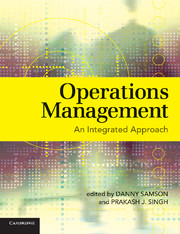Book contents
- Frontmatter
- Contents
- List of Contributors
- Preface
- Acknowledgements
- Part I Operations within Organisations – Building Blocks
- 1 What is Operations Management and Why is it Important?
- 2 Operating System Models
- 3 Key Decisions in OM
- 4 Planning and Controlling the Use of Operating Assets and Resources
- Part II Approaches to Understanding OM
- Part III Moving Forward with OM – Creating Competitive Advantage
- Part IV Challenges and Opportunities in Operations
- Part V Case Studies
- Index
- References
1 - What is Operations Management and Why is it Important?
Published online by Cambridge University Press: 05 June 2012
- Frontmatter
- Contents
- List of Contributors
- Preface
- Acknowledgements
- Part I Operations within Organisations – Building Blocks
- 1 What is Operations Management and Why is it Important?
- 2 Operating System Models
- 3 Key Decisions in OM
- 4 Planning and Controlling the Use of Operating Assets and Resources
- Part II Approaches to Understanding OM
- Part III Moving Forward with OM – Creating Competitive Advantage
- Part IV Challenges and Opportunities in Operations
- Part V Case Studies
- Index
- References
Summary
Learning objectives
After reading this chapter, you should be able to:
define the meaning of ‘operations management’
explain the role of operations management within organisations, including how it relates to other functional areas
describe the differences and similarities between goods and services, and show how these affect our understanding of operations management
describe the decisions that fall within the field of operations management;
discuss the trends that are encouraging organisations to focus on their operations
trace the historical evolution of the field
describe typical careers that can be developed within the operations management area.
Box 1.1: Management challenge: Woolworths Limited
Woolworths Limited is the largest retailer in Australia, collecting about 18 cents in every dollar spent in the retail industry. With a nominal capital of 25,000 pounds (approximately $A70,000 today), Woolworths opened its first store in Sydney in 1924. The company posted annual revenue of close to $38 billion, and net operating profit of over $1 billion in 2006. Along with its flagship Woolworths and Safeway supermarkets (which has close to 40 per cent market share in that industry sub-sector), it also owns Dick Smith Electronics, Tandy Electronics, Big W discount store chain, and Dan Murphy's liquor stores, among others. It has also formed alliances with companies such as Caltex to retail petrol. Currently, it operates close to 3,000 stores, petrol stations and hotels in Australia and New Zealand. The company employs more than 140,000 people. […]
- Type
- Chapter
- Information
- Operations ManagementAn Integrated Approach, pp. 3 - 36Publisher: Cambridge University PressPrint publication year: 2008

